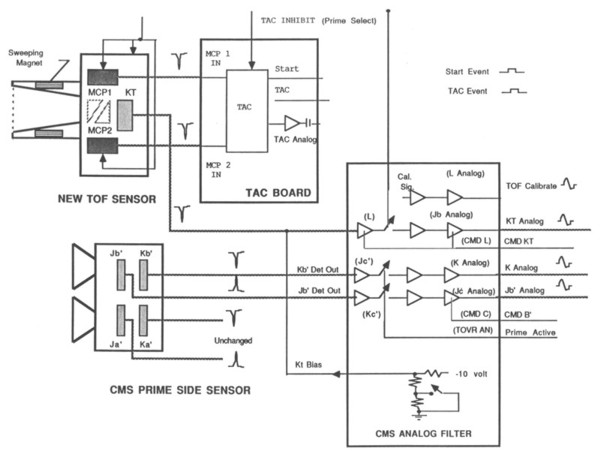GALILEO
Return to main
Galileo Table of Contents Page.
The Galileo Energetic Particles Detector
Galileo EPD Handbook
Chapter 1. Instrument Summary
CMS Rate Channels - Post-Challenger Information
Source: Critical Design Review, December 1987
Changes to existing circuit boards:
Description of New Hardware Tasks
- Process KT detector signal
- Control high voltage converter
- Switch HVPS power by command
- Route new signals through polytwist
- Process events
- Add additional RAM to data system
- Change J'C aperture into J'B
Figure 1-23. Proposed configuration changes for new EPD CMS subsystem
Spacecraft interface
- No new wires or signals required for new configuration
- Additional load on main spacecraft 15 voltage bus
for HVPS
- EPD is on the protected spacecraft bus
- Fuse protected (redundant)
- Relay switched by protected command
- Possible EMI/EMC interaction; measured by testing at JPL SAF
Analog filter board rework
- Functional description of changes
- KT signal processed by old L and JB amps
- JB' and KB' signal into old JC' and KC' amps
- JB bias, KT bias
- Calibrator signal into TOF channel (TCAL)
- Mounted inside new TOF box
- Parts questions: none
- Functional testing results: no major problems; difficulty switching KT bias
- Known outstanding design issue: select proper K bias network
- Scope: Add 7 components, remove 15; add 7 lines, remove 11
Figure 1-24. Functional Block Diagram of Analog Filter Board
CMS analog electronics
- Basic board operation
- Functional description of changes
- KT signal processed by old JC' amps
- Discriminator input routing changed
- Mass channels defined by KT and T (not K)
- Valid event logic definitions changed
- Calibrator signal into TOF channel (TCAL)
- Component packaging: unchanged
- Parts questions: none
- Functional testing results: no major problems; more rate testing, etc., necessary
- Known outstanding design issues: TCAL signal not sent to rate logic or PHA
- Scope: Add 2 components, remove 14; add 20 lines, remove 16
Figure 1-25. CMS analog electronics chain
CMS rate logic (new version of previous design)
- Functional description of changes
- New rate channel definitions for KT x T
- Elimination of CE, CP, and JC channels
- New ID code format
- Component packaging: minor changes
- Parts questions: limited accumulator hybrids
- Functional testing results: no problems
- Known outstanding issue: calibrator mux assignments must be modified
Low voltage power converter
- Basic board operation
- Functional description of changes
- Relay (K71) to switch 15 volts for HVPS
- Old "JA00" command line used to command K71
- Filter replaces divider on "K bias board"
- 3 volt dummy loads removed - zenors added
- Component packaging: minor changes
- Parts questions: none
- Functional testing results: no problems
- Known outstanding design issues: none
- Scope: Add 10 components, remove 4; add 4 lines, remove 10
Next: CMS Rate Channels - Pre-Challenger Information
Return to the CMS Subsystem Index
Return to Galileo EPD Handbook Table of Contents Page.
Return to main
Galileo Table of Contents Page.
Return to Fundamental
Technologies Home Page.
Updated 8/23/19, Cameron Crane
QUICK FACTS
Manufacturer: The Galileo Spacecraft
was manufactured by the Jet Propulsion Laboratory,
Messerschmitt-Bölkow-Blohm, General Electric, and the
Hughes Aircraft Company.
Mission Duration: Galileo was planned to have a mission duration of around 8 years, but was kept in operation for 13 years, 11 months, and 3 days, until it was destroyed in a controlled impact with Jupiter on September 21, 2003.
Destination: Galileo's destination was Jupiter and its moons, which it orbitted for 7 years, 9 months, and 13 days.
Mission Duration: Galileo was planned to have a mission duration of around 8 years, but was kept in operation for 13 years, 11 months, and 3 days, until it was destroyed in a controlled impact with Jupiter on September 21, 2003.
Destination: Galileo's destination was Jupiter and its moons, which it orbitted for 7 years, 9 months, and 13 days.






